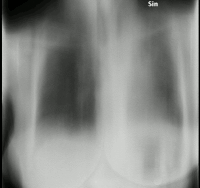
Photo from wikipedia
The importance of this research lies in the demonstration that siderophore analysis can distinguish between asymptomatic colonization and invasive pulmonary aspergillosis. We found clear associations between phases of fungal development,… Click to show full abstract
The importance of this research lies in the demonstration that siderophore analysis can distinguish between asymptomatic colonization and invasive pulmonary aspergillosis. We found clear associations between phases of fungal development, from conidial germination to the proliferative stage of invasive aspergillosis, and changes in secondary metabolite secretion. ABSTRACT Germination from conidia to hyphae and hyphal propagation of Aspergillus fumigatus are the key pathogenic steps in the development of invasive pulmonary aspergillosis (IPA). By applying in vitro observations in a clinical study of 13 patients diagnosed with probable IPA, here, we show that the transition from colonization to the A. fumigatus invasive stage is accompanied by the secretion of triacetylfusarinine C (TafC), triacetylfusarinine B (TafB), and ferricrocin (Fc) siderophores into urine, with strikingly better sensitivity performance than serum sampling. The best-performing index, the TafC/creatinine index, with a median value of 17.2, provided 92.3% detection sensitivity (95% confidence interval [CI], 64.0 to 99.8%) and 100% specificity (95% CI, 84.6 to 100%), i.e., substantially better than the corresponding indications provided by galactomannan (GM) and β-d-glucan (BDG) serology. For the same patient cohort, the serum GM and BDG sensitivities were 46.2 and 76.9%, respectively, and their specificities were 86.4 and 63.6%, respectively. The time-dependent specific appearance of siderophores in the host’s urine represents an impactful clinical diagnostic advantage in the early discrimination of invasive aspergillosis from colonization. A favorable concentration of TafC in a clinical specimen distant from a deep infection site enables the noninvasive sampling of patients suffering from IPA. IMPORTANCE The importance of this research lies in the demonstration that siderophore analysis can distinguish between asymptomatic colonization and invasive pulmonary aspergillosis. We found clear associations between phases of fungal development, from conidial germination to the proliferative stage of invasive aspergillosis, and changes in secondary metabolite secretion. The critical extracellular fungal metabolites triacetylfusarinines C and B are produced during the polarized germination or postpolarized growth phase and reflect the morphological status of the proliferating pathogen. False positivity in Aspergillus diagnostics is minimized as mammalian cells do not synthesize Aspergillus siderophore or mycotoxin molecules.
Journal Title: Microbiology Spectrum
Year Published: 2023
Link to full text (if available)
Share on Social Media: Sign Up to like & get
recommendations!